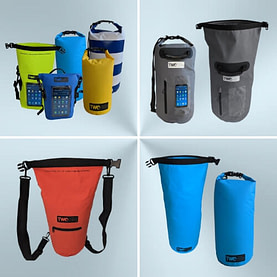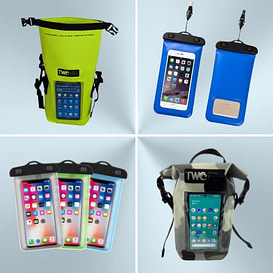Our Top Rated Products
MOST POPULAR
Waterproof Phone Cases
Mobile Phone Bags, Waterproof Phone Totes. Sand-Proof, Dust Proof, Waterproof. They Float. Assorted Colors. Customized Logo.
Beach, Boating, Watersports, Fishing, Hunting, Camping, Off Road, Golf, Running, Hiking, Biking.
Waterproof Dry Bag Tubes
Lorem ipsum dolor sit amet, consectetur adipisicing elit, sed do eiusmod tempor incididunt ut labore et dolore magna aliqua. Ut enim ad minim veniam, quis nostrud exercitation ullamco laboris

Waterproof Backpack Dry Bags
Lorem ipsum dolor sit amet, consectetur adipisicing elit, sed do eiusmod tempor incididunt ut labore et dolore magna aliqua. Ut enim ad minim veniam, quis nostrud exercitation ullamco laboris
Waterproof Dry Bag Tubes
Lorem ipsum dolor sit amet, consectetur adipisicing elit, sed do eiusmod tempor incididunt ut labore et dolore magna aliqua. Ut enim ad minim veniam, quis nostrud exercitation ullamco laboris


With so much marketing and so many options that feature waterproof, how to choose the best waterproof bag or case is tricky business.
The thing is, waterproof is one of those features that almost always requires some “special investigation” to get to the bottom line.
- “Is that fabric really waterproof?
- “How can a tote be totally waterproof if it is sewn together at the seams” ?
- “Is a roll top waterproof bag better than a dry bag with a waterproof zipper?”
So we are going to address concerns like that with this post.
First, we’ll help you to answer, “How much waterproof protection is necessary for me and my activities?”
Then we will detail how to evaluate the 3 most important construction features of the waterproof bag, backpack, or “carry-all”.
With this information you will be informed and confident when it is time to choose the best waterproof bag for your activities.
Choose The Best Waterproof Bag
- Your “Most Often Use”
- The Commuter
- The Recreator
- The Professional
- The IP Code
- Critical Construction Features
- The Fabric or Material
- Integrity at the Seams
- The Closure System
Your Most Often Use
Which of 3 different profiles describes how you use your waterproof gear?
Are you The Commuter?
Are you The Recreator?
Or, are you The Professional?

The Commuter
The Commuter is the guy or gal that uses a carry-all to protect valuables from wind, dust, snow or rain. That means your most often use is to shelter your stuff when the weather is inclement.
Technically, The Commuter is looking to prevent the ingress of water, for a short period of time. That would be, as long as it takes to find cover from the rain, sleet, or snow.
Runners, walkers, bicycle or railway commuters, and trail sports folks are all great examples.
But when a downpour becomes a “dunk”, or a “submersion”; that’s when The Commuter needs the same kind of waterproof protection as The Recreator.
The Recreator
Next is the person who intentionally includes the water in their outdoor recreation.
You’re into water sports. Or, it’s the beach. Maybe you’re thinking about boating, a waterproof backpack for jet skiing, or a dry bag for kayaking.
Everybody who enjoys a swimming pool, rivers, lakes or the ocean needs a waterproof cell phone case that floats.
The Recreator needs gear that offers protection from a constant spray or powerful splashing, as well as a shallow submersion.
By the way, consider a “shallow submersion” several inches to 4 feet underwater, for a few seconds or more.
The Professional
Finally, there is The Professional profile. These are folks who carry valuables into challenging environments or extreme conditions.
Generally, those conditions involve total submersion or significant water pressure for an extended period of time.
Scuba and deep water divers, law enforcement and emergency personnel and folks who need to keep their ammunition dry while they are duck hunting are a few examples.
Your MOST OFTEN USE should guide you as you answer….
“How much waterproof protection is enough for me?”.
So, it’s plain to see. Everybody needs to protect belongings from water, at some point.
Water-Resistant bags and cases are sufficient for lots of folks in The Commuter profile. For others, totally waterproof is a necessity.
The IP Code
The term “waterproof” has been defined by international authorities to represent very specific standards. Sometimes the standards are presented as an Ingress Protection Marking, or an IP Code.
An IP Code classifies and ranks “degrees of protection” from dust and water under specific laboratory conditions and testing methods.
In other words, an IP Code offers guidance about, “How much waterproof is appropriate for my most often use?”.
https://www.cincinnati-test.com/ipxx-leak-testing.html
Honestly, marketers and salespeople play fast and loose with the term “waterproof” notoriously, despite these official standards . So you should pay careful attention to 3 critical construction features, once you have determined your most often use.
3 Critical Construction Features
There are three components that are most important to evaluate as you choose the best waterproof bag for your favorite activities.
Be aware that these are the features that distinguish water-resistant from waterproof bags and cases.
- Material – The fabric or material with which the product is made.
- Seams – Integrity at the seams, handles and fixtures.
- Closure – How effective is the closure mechanism.
The Material
The material is the first feature that I examine when I am evaluating a bag or case.
I want to know, “Is it made with a woven fabric?”. Or, “Is the carry-all made with an extruded material?”.
For instance, canvas is very common in the construction of backpacks, duffels and totes. Canvas is a woven fabric. That means lots of space for water to infiltrate, between the fibers. So canvas needs additional treatment in order to provide protection from water or moisture.
Frequently, canvas is treated with a Durable Water Repellent on one side. DWR on the face of a woven fabric delays or prevents a material from becoming saturated. It causes water to bead up and roll off the facial surface.
Sometimes, the second surface is treated with rubber, pvc, or a coating with similar properties. Manufacturers refer to fabrics treated with multiple layers as laminates. And laminates provide better protection from water than fabrics with single layer treatment.

Backpacks, duffles, totes and cases that are constructed with laminates tend to be well suited and appropriate for The Commuter and her challenges. Conversely, The Professional profile needs bags and cases that are made with thermoplastics.
So what are thermoplastics?
Thermoplastics are plastic polymers that are “moldable” when they are heated.
Manufacturers extrude thermoplastics into the materials that are used to make waterproof backpacks, duffels and totes. Or, they mold these polymers into waterproof boxes and cases.
Most important, thermoplastics are inherently waterproof. Also, they are ideal for RF Welding and great for bonding fixtures and closure systems.
The Seams
Next, we’ve got to consider the seams; the folds, the corners, and the attachments. Are they sewn, taped, or welded?
Seams that are stitched tightly can work quite effectively if your most often use is to protect your valuables from bad weather.
Be aware, however, that sewn fabric is punctured. Consequently, powerful splashing or water pressure might enable water to infiltrate your carry-all.

The technique that is used to hold a carry-all together at the seams is the feature that distinguishes bags and cases suitable for The Recreator.
Seams that are sewn will not do when your activities subject your carry-all to heavy spray or submersion. Consequently, glued, taped or welded seams are highly recommended for The Recreator and The Professional.
The Closure
The closure system is the last of 3 critical construction features.
Ordinarily, we are looking for a waterproof seal when we close up a waterproof bag or case.
But lots of Commuters use a backpack or duffel that does not provide a leak-proof seal to shield their valuables from bad weather.
Options about closure systems offer a range of effectiveness, just like your options about materials and seams.
A totally waterproof container is a pack, a duffel, or a case that combines impenetrable material and welded seams with a leak-proof closure system.
Generally, closure systems on waterproof carry-alls organize into 4 categories
- Clamps & Gaskets
- Zippers
- Zip Seals
- Roll Top
1. Clamps & Gaskets
Most hard waterproof cases use rubber or silicone gaskets and a clamp mechanism to create a seal. Look for an IP Code and let it be your guide.

2. Zippers
To start, we should acknowledge that zippers are the most common system for closing bags, backpacks, duffels and cases.
Second, let’s note that a zipper is a fastener. A fastener draws together, or “attaches” two ends. But the mechanism was not conceived as a device that would create a “seal”.
Without significant modification, a common zipper does not provide a lot of waterproof protection. Heavy rain or splashed water leaks through the elements of a coil zipper easily.
So designers frequently cover a common coil zipper with a flap. That design offers water-resistant protection for the The Commuter.
A reverse coil zipper is another solution that can work for The Commuter. These are modified coil zippers that are also categorized as water–resistant.

Next is zippers that are waterproof. Most waterproof zippers are molded thermoplastics. They are far more effective as a defense against the water pressure that comes with powerful splashing or shallow submersion.
Better quality waterproof zippers are welded to a thermoplastic material. And that combination renders a waterproof bag that is suitable for The Recreator.
Finally, we have airtight zipper systems.
Originally these mechanisms were designed to maintain air pressure within a space suit. Since then airtight zippers have been adapted for use on deep sea drysuits, as well as heavy duty and industrial grade waterproof gear.
Get more:
5 Things to know About Waterproof Zippers.
3. Zip Seals
Zip seals are another common closure system. These are used a lot on waterproof cell phone bags and a variety of duffels.
“Long and Straight” is a key feature to look for in a zip seal system. That’s because bends and turns can challenge the effectiveness of a zip seal.
Also, zip seal systems can be vulnerable to burst pressure, which is a tendency to blow open from the inside out. That happens when the external pressure becomes too much.


The most effective system for closing up a waterproof bag is a properly executed roll top closure.
4. Roll Top
Personally, I still find it to be amazing; mostly because by 2019 you’d think that innovating designers would have offered something new. But, the simple truth is the roll-top system remains the most reliable waterproof closure system.

Furthermore, a common and effective design is to include a roll top on waterproof backpacks, duffels and totes as a supplement to water-resistant zippers and zip seals.
Finally, a roll-top dry bag is the prototypical waterproof container for water sports and outdoor recreation. Be sure to keep this in mind as you choose the best waterproof bag for your activities.
Get more tips about waterproof gear
Get the info about new products
Be informed as innovations hit the marketplace
Tags
dry bags, roll top dry bags, roll top waterproof backpack, waterproof bags, waterproof material, waterproof zippers



